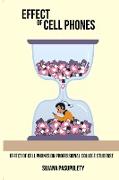Effect of cell phones on professional college students
BücherAngebote / Angebote:
ABSTRACT Wireless communication technologies have become widespread all over the world. In 2006, 90.9% of people in the developed countries and 32.4% of people in the developing countries owned a cellular phone (ITU, 2006). Over the last decade the mobile phone has penetrated in every sector, presenting many opportunities to many areas, including higher education (Campbell, 2002). According to Brown et al. (2002), several features contribute to the popularity of the mobile phone, but it is the 'mobile component' of the mobile devices which is the most important feature. Mobile communication offers a lot of advantages but it has also negative aspects. In response to a question about mobile-phone addiction, one out of three students said that they felt addicted to their phones. This sense of addiction may be related to dependency and heavy usage (Katz, 2005). The study was conducted on a sample of 613 students belonging to Medical and Engineering Colleges. In Medical, there were 436 students and in Engineering there were 177 students. There were 347 students below 20 years of age and 266 students above 20 years of age. And, the sample included 251 males and 362 females.
Folgt in ca. 15 Arbeitstagen




